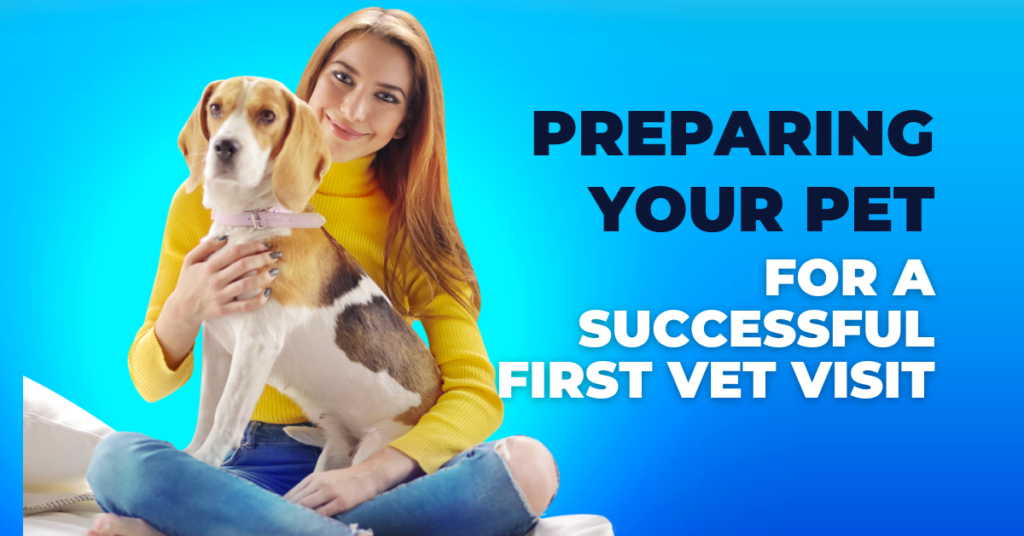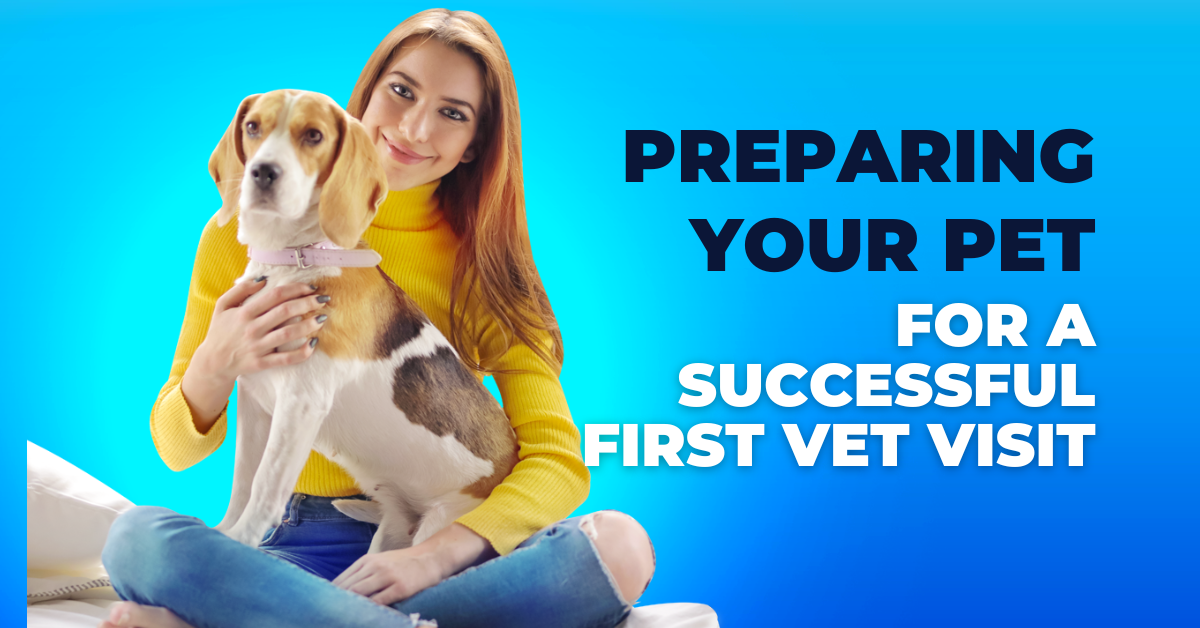When it comes to pet ownership, taking care of your furry friend’s health and well-being is a top priority. This includes regular visits to the veterinary clinic, which can be stressful for both you and your pet, especially if it’s their first time. Preparing your pet for their first vet visit can help make the experience more positive and less overwhelming for everyone involved.
In this blog post, we’ll share a few tips to help you prepare your pet for a successful first vet visit. From choosing the right vet to acclimating your pet to their carrier or leash, practicing handling at home, and using positive reinforcement, we’ll cover everything you need to know to make your pet’s first vet visit as stress-free and successful as possible.
Whether you’re a new pet owner or a seasoned pro, these tips can help you and your furry friend feel more confident and comfortable during the vet visit. So, let’s get started!

Choose the Right Vet
Choosing the right vet ensures that your pet gets the best care. A good vet fits you and your beloved pet. Tips for choosing the right vet for your pet:
- Referrals: A good place to start is to get suggestions from people you know who already have pets. They may suggest a vet they trust and like.
- Browse: Check online reviews and ratings for vets in your area. You can also check their websites or social media pages to get an idea of their services and philosophy.
- Schedule a visit: After narrowing your list, visit the vet. You can meet the vet and staff, tour the building, and learn about their pet care philosophy.
- Pet needs: Some pets may have specific needs, such as a senior pet or a pet with a chronic condition. Choose a vet with knowledge in your pet’s needs.
- Trust yourself: In the end, go with your gut feeling when picking a veterinarian. Asking about your pet’s health should be easy.
Research and choose the best vet for your pet to ensure a successful first visit.
Acclimate Your Pet to the Carrier or Leash
Getting your pet comfortable with their carrier or leash is important for a successful vet visit. Here are some tips to help your pet get used to their carrier or leash before the vet visit:
- Introduce the carrier or leash gradually: Start by leaving the carrier or leash out in a common area of your home so that your pet can get used to it.
- Make it comfortable: Add a soft blanket or towel to the carrier to make it more inviting. Attach a favorite toy or treat to the leash to make it more appealing.
- Associate it with positive experiences: Feed your pet their meals inside the carrier or leash, or give them treats while they’re wearing the leash. This will help your pet associate the carrier or leash with positive experiences.
- Take short trips: Once your pet is comfortable with the carrier or leash, take them on short trips around the house or outside. This will help them get used to being in the carrier or on a leash.
By acclimating your pet to their carrier or leash, you’ll be helping them feel more comfortable and secure during the vet visit.
Practice Handling Your Pet
Getting your pet used to being handled by strangers is important for a successful vet visit. Here are some tips to help you practice handling your pet at home:
- Start slowly: Begin by gently touching your pet’s paws, ears, and other sensitive areas. Gradually work up to handling them more extensively.
- Use positive reinforcement: Offer treats and praise when your pet allows you to handle them without fussing.
- Involve others: Ask friends or family members to help with handling practice so that your pet gets used to being handled by different people.
- Gradually increase duration: Increase the amount of time you spend handling your pet each day to help them get used to it.
By practicing handling your pet, you’ll be helping them feel more comfortable and calm during the vet visit.
Stay Calm and Confident
As a pet owner, you play a crucial role in helping your pet feel calm and confident during their first vet visit. Pets can pick up on their owner’s emotions, so projecting a sense of calm and confidence can go a long way in helping your pet feel relaxed and at ease. Here are some tips for staying calm and confident during the visit:
- Take deep breaths: If you feel nervous or anxious, take a few deep breaths to help calm your nerves. This can help you project a sense of calm to your pet.
- Use a reassuring tone of voice: When speaking to your pet, use a calm and reassuring tone of voice. This can help ease any anxiety your pet may be feeling.
- Maintain a positive attitude: Even if your pet is nervous or scared, try to maintain a positive attitude. Your pet will pick up on your positive energy and it can help them feel more comfortable.
- Don’t rush: Take your time during the appointment and don’t rush your pet.
- Use gentle touch: If your pet is nervous or scared, use gentle touch to help calm them.
By staying calm and confident, you can help your pet feel more at ease during their first vet visit. Remember, your pet looks to you for comfort and reassurance, so projecting a sense of calm and confidence can make all the difference in helping your pet feel comfortable and safe.
Consider a “Dry Run”
A “dry run” is a practice run that you can do with your pet before the actual vet visit. A dry run can help your pet become more familiar with the experience of going to the vet and can help reduce anxiety and stress. Here are some tips for doing a dry run with your pet:
- Start with short trips: Begin by taking your pet on short car rides or walks to get them used to the idea of leaving the house. To get your pet used to moving, gradually lengthen these trips.
- Use a carrier or leash to get your pet used to being contained and moved. Practice carrying or leashing your pet around the home or yard.
- Imitate the vet: Create a home practice exam room with a table or elevated surface for your pet to lie on. Handle and examine your cat like a vet.
- Treats and positive feedback can help your pet relax during the dry run. Treat and reward calmness.
- Take notes during the dry run to recall any issues or concerns. This can prepare you for the vet visit and meet your pet’s needs.
By doing a dry run with your pet, you can help them become more comfortable and familiar with the experience of going to the vet. Remember to take it slow and use positive reinforcement to make the experience as positive and stress-free as possible for your pet.
Arrive Early
Arriving early to your pet’s first vet visit can help reduce stress and anxiety for both you and your pet. Here are some tips for planning ahead and arriving early:
- Plan for traffic and parking: Research the route to the vet clinic and plan for any potential traffic delays or construction. Also, check the parking situation at the clinic and plan to arrive early enough to find a convenient parking spot.
- Fill out paperwork in advance: Most vet clinics will have paperwork that you need to fill out before the appointment. Consider filling out this paperwork in advance, either by printing it out at home or arriving early enough at the clinic to fill it out before the appointment.
- Let your pet explore the clinic: Arriving early gives your pet time to explore the clinic and become familiar with the surroundings. This can help reduce anxiety and stress during the actual exam.
- Talk to the vet or staff: Arriving early also gives you the opportunity to talk to the vet or staff and ask any questions you may have. This can help you feel more informed and prepared for the appointment.
By arriving early to your pet’s first vet visit, you can help reduce stress and anxiety for both you and your pet. Remember to plan ahead, fill out paperwork in advance, let your pet explore the clinic, talk to the vet or staff, and allow time for unexpected issues.
Communicate Effectively with Your Vet
For the best pet care, you must communicate with your vet. Here are some tips for communicating effectively with your vet:
- Ask: Ask about your pet’s health, behavior, or worries. Your vet wants you to know everything.
- Honesty: Be honest with your vet about your pet’s health and behavior, even if you feel embarrassed or ashamed.
- Vet advice: Follow your vet’s pet-care advice. If you have any concerns or questions, don’t hesitate to ask for clarification.
- Speak up for your pet’s wants. Your vet should collaborate with you to provide top-notch pet care.
Communicating with your vet can help your pet get the best care. Ask questions, be honest, listen to the vet, advocate for your pet, and follow up.
Conclusion
Preparing your pet for their first vet visit can help reduce stress and anxiety for both you and your furry friend. By following these 10 tips, you can help ensure a successful first vet visit for your pet. Remember to choose the right vet, acclimate your pet to the carrier or leash, practice handling your pet, plan for your pet’s needs, stay calm and confident, use positive reinforcement, consider a “dry run,” arrive early, and communicate effectively with your vet. By taking these steps, you can help ensure that your pet receives the best possible care and build a positive relationship with your vet. Don’t forget to share your own tips and experiences in the comments section and happy vet visiting!





